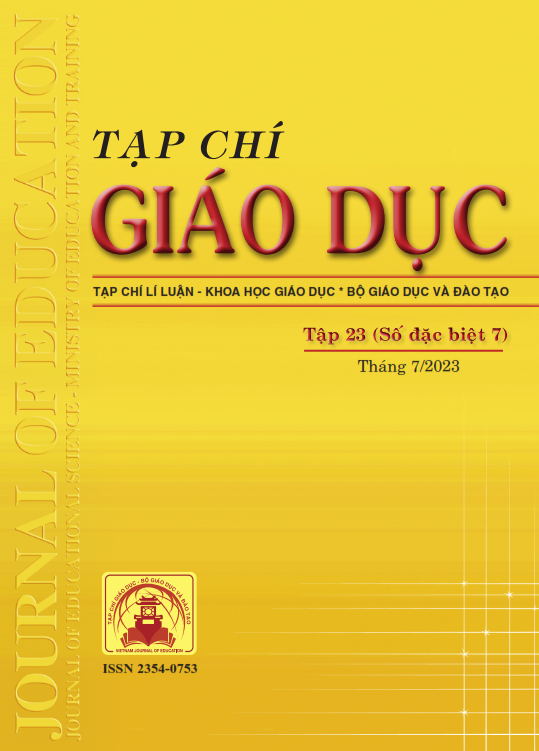Nguyên tắc và quy trình thiết kế phim hoạt hình hỗ trợ dạy học môn Khoa học tự nhiên lớp 9
Tóm tắt
Cartoon is one of the most popularly used digital learning materials in academic settings with information technology applications. However, the impact of using this tool in teaching can be affected because of many distractions that hinder the learning process. Based on the theory of Cognitive Theory of Multimedia Learning, the theory of Cognitive Loading, and Twelve Design Principles of Multimedia Learning, the article proposes a set of principles for cartoon design to be used in teaching grade 9 Natural Science. The results of pedagogical experiments on 151 students show that cartoons designed with 04 principles and a 06-step process can help students improve their understanding, form knowledge structure, and interest in learning Natural Science.
Tài liệu tham khảo
Barak, M., & Dori, Y. J. (2004). Enhancing undergraduate students’ chemistry understanding through project-based learning in an IT environment. Science Education, 89(1), 117-139. https://doi.org/10.1002/sce.20027
Barak, M., Ashkar, T., & Dori, Y. J. (2011). Learning science via animated movies: Its effect on students’ thinking and motivation. Computers & Education, 56(3), 839-846. https://doi.org/10.1016/j.compedu.2010.10.025
Bloom, B. S. (1956). Taxonomy of Educational Objectives: The Classification of Educational goals. Handbook 1, Cognitive Domain. New York: Longman.
Brünken, R., Plass, J. L., & Leutner, D. (2004). Assessment of Cognitive Load in Multimedia Learning with Dual-Task Methodology: Auditory Load and Modality Effects. Instructional Science, 32(1/2), 115-132. https://doi.org/10.1023/b:truc.0000021812.96911.c5
Cohen, J. (1988). Statistical power analysis for the behavioral sciences (2nd ed.). Hillsdale, N.J.: L. Erlbaum Associates.
Dalacosta, K., Kamariotaki-Paparrigopoulou, M., Palyvos, J. A., & Spyrellis, N. (2009). Multimedia application with animated cartoons for teaching science in elementary education. Computers & Education, 52(4), 741-748. https://doi.org/10.1016/j.compedu.2008.11.018
Đặng Đức Trọng, Lê Quốc Dũng (2017). Giới thiệu một số khái niệm căn bản của Lí thuyết tải nhận thức. Tạp chí Khoa học, Trường Đại học Sư phạm Thành Phố Hồ Chí Minh (HCMUE J. Sci.), 14(4), 110-118. https://journal.hcmue.edu.vn/index.php/hcmuejos/article/view/197/189#
Gerrig, R. J. (1988). Text comprehension. In R. J. Sternberg & E. E. Smith (Eds.), The psychology of human thought (pp. 242-266). Cambridge University Press.
Guo, P. J., Kim, J., & Rubin, R. (2014). How video production affects student engagement. Proceedings of the First ACM Conference on Learning. https://doi.org/10.1145/2556325.2566239
Halas, J. (1976). Film Cartoon: A Simplified Approach. UNESSCO, Monographs on communication technology and utilization. Printed in Switzerland.
Mayer, R. E. (2001). Multimedia Learning. Cambridge University Press. https://doi.org/10.1017/cbo9781139164603
Mayer, R. E. (2019). Cognitive Theory of Multimedia Learning. The Cambridge Handbook of Multimedia Learning, 3, 43-71. https://doi.org/10.1017/cbo9781139547369.005
Mayer, R. E., & Fiorella, L. (2014). Principles for Reducing Extraneous Processing in Multimedia Learning: Coherence, Signaling, Redundancy, Spatial Contiguity, and Temporal Contiguity Principles. The Cambridge Handbook of Multimedia Learning, 279-315. Cambridge Handbooks in Psychology. https://doi.org/10.1017/cbo9781139547369.015
Mayer, R. E., & Moreno, R. (2003). Nine Ways to Reduce Cognitive Load in Multimedia Learning. Educational Psychologist, 38(1), 43-52. https://doi.org/10.1207/s15326985ep3801_6
Mayer, R. E., Heiser, J., & Lonn, S. (2001). Cognitive constraints on multimedia learning: When presenting more material results in less understanding. Journal of Educational Psychology, 93(1), 187-198. https://doi.org/10.1037/0022-0663.93.1.187
Moreno, R., & Mayer, R. E. (2000). A coherence effect in multimedia learning: The case for minimizing irrelevant sounds in the design of multimedia instructional messages. Journal of Educational Psychology, 92(1), 117-125. https://doi.org/10.1037/0022-0663.92.1.117
Nguyễn Quang Hùng, Hứa Mỹ Linh (2022). Kết hợp xây dựng câu chuyện và trò chơi toán học trong dạy học môn Toán lớp 3, 4. Tạp chí Khoa học, Trường Đại học Đồng Tháp, 11(4), 41-50. https://doi.org/10.52714/dthu.11.4.2022.965
Oppenheimer, T. (2004). The flickering mind : saving education from the false promise of technology. New York: Random House Trade Paperbacks.
Phan Thị Tình, Mai Thị Thu Uyên (2022). Thiết kế phim hoạt hình hỗ trợ dạy học môn Toán lớp 2 theo hướng kết nối tri thức với thực tiễn. Tạp chí Giáo dục, 22(6), 8-12.
Schnotz, W. (2008). Learning with Cartoon: research implications for design. Éditeur: Cambridge; New York: Cambridge University Press.
Schnotz, W., & Rasch, T. (2005). Enabling, facilitating, and inhibiting effects of Cartoons in multimedia learning: Why reduction of cognitive load can have negative results on learning. Educational Technology Research and Development, 53(3), 47-58. https://doi.org/10.1007/bf02504797
Sweller, J. (1988). Cognitive Load During Problem Solving: Effects on Learning. Cognitive Science, 12(2), 257-285. https://doi.org/10.1207/s15516709cog1202_4
Sweller, J., van Merrienboer, J. J. G., & Paas, F. G. W. C. (1998). Cognitive Architecture and Instructional Design. Educational Psychology Review, 10(3), 251-296. https://doi.org/10.1023/a:1022193728205
Thủ tướng Chính phủ (2020). Quyết định số 749/QĐ-TTg ngày 20/6/2020 của Thủ tướng Chính phủ phê duyệt “Chương trình Chuyển đổi số quốc gia đến năm 2025, định hướng đến năm 2030”.
Đã Xuất bản
Cách trích dẫn
Số
Chuyên mục
Giấy phép

Tác phẩm này được cấp phép theo Ghi nhận tác giả của Creative Commons Giấy phép quốc tế 4.0 .












